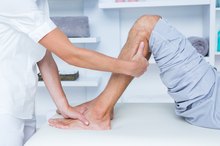What does fact checked mean?
At Healthfully, we strive to deliver objective content that is accurate and up-to-date. Our team periodically reviews articles in order to ensure content quality. The sources cited below consist of evidence from peer-reviewed journals, prominent medical organizations, academic associations, and government data.
The information contained on this site is for informational purposes only, and should not be used as a substitute for the advice of a professional health care provider. Please check with the appropriate physician regarding health questions and concerns. Although we strive to deliver accurate and up-to-date information, no guarantee to that effect is made.
Blood Clots & Flat Red Spots on Legs
Blood clots, also known as deep vein thrombosis, can be a potentially serious condition that must be treated immediately. Blood clots are often found on the arms and legs and in people who are not able to move around to allow for proper circulation. Individuals on bed rest and the elderly are most susceptible to blood clots. Flat red spots may be found around the clotted area, and can serve as a sign that a clot is present.
If you are experiencing serious medical symptoms, seek emergency treatment immediately.
Blood clots are most typically found in sedentary individuals. People over the age of 65, obese and severely ill people are at risk for blood clots. Clots can also result from being confined to a small space for long periods of time time, such as when taking long trips in a car or plane. Symptoms include swelling in the arms and legs, redness, warm red spots and soreness, though many people with deep vein thrombosis do not have symptoms.
Diagnosis
There are several ways to diagnose blood clots. Your doctor may perform an ultra sound, a CT or a MRI scan. Blood tests can also diagnose blood clots. Individuals whose blood have higher levels of a clotting substance called D-dimer serve to indicate that a clot may be present. If suffering from deep vein thrombosis, your doctor will prescribe medication and offer exercises to help manage you symptoms.
- There are several ways to diagnose blood clots.
Complications
Blood Clot Exercise Precautions
Learn More
Blood clots can progress to a more serious condition if not properly treated 1. The Mayo Clinic warns that blood clots can travel to your lungs and cause pulmonary embolisms 12. If a blood clot manages to block a major artery, it can be life threatening. People with congenital heart defects are at risk of clots traveling to their coronary artery, which can cause a heart attack or stroke. Blood clots can also cause varicose veins, discoloration and permanently block blood flow to certain veins.
- Blood clots can progress to a more serious condition if not properly treated 1.
- People with congenital heart defects are at risk of clots traveling to their coronary artery, which can cause a heart attack or stroke.
Treatment
There are several self-care remedies to help relieve the pain cause by blood clots 1. If the blood condition is not severe and is more superficial, it is recommended that you apply a warm wash cloth over the affected area daily. Anti-coagulation medications and prescribed support stockings can help reduce the symptoms of deep vein thrombosis. If you have blood clots, consult your doctor if you experience vein swelling, high fever or shortness of breath.
- There are several self-care remedies to help relieve the pain cause by blood clots 1.
- Anti-coagulation medications and prescribed support stockings can help reduce the symptoms of deep vein thrombosis.
Prevention
What Are the Symptoms of a Blood Clot in Your Ankle?
Learn More
The United States Department of Health and Human Services recommends that if you are at risk for blood clots raise your legs at least 6 inches above your head from time to time. It is also advisable to not stand or sit for more than one hour at a time, minimize your consumption of salty foods and wear loose fitting socks or stockings.
Related Articles
References
- Agency for Healthcare and Research Quality: Your Guide to Preventing and Treating Blood Clots
- Mayo Clinic: Thrombophlebitis
- Andrade AR, Barros LL, Azevedo MFC, et al. Risk of thrombosis and mortality in inflammatory bowel disease. Clin Transl Gastroenterol. 2018;9(4):142. doi:10.1038/s41424-018-0013-8
- Faye AS, Wen T, Ananthakrishnan AN, et al. Acute venous thromboembolism risk highest within 60 days after discharge from the hospital in patients with inflammatory bowel diseases. Clin Gastroenterol Hepatol. 2019. doi:10.1016/j.cgh.2019.07.028
- American Society of Hemotology. Blood clots.
- Centers for Disease Control and Prevention. Data and statistics on venous thrombolism. Updated March 14, 2019.
- American Heart Association. Understanding your risk for excessive blood clotting.
- Kappelman MD, Horvath-puho E, Sandler RS, et al. Thromboembolic risk among Danish children and adults with inflammatory bowel diseases: a population-based nationwide study. Gut. 2011;60(7):937-943. doi:10.1136/gut.2010.228585
- Grainge MJ, West J, Card TR. Venous thromboembolism during active disease and remission in inflammatory bowel disease: a cohort study. Lancet. 2010;375(9715):657-663. doi;10.1016/S0140-6736(09)61963-2
- Nguyen GC, Bernstein CN, Bitton A, et al. Consensus statements on the risk, prevention, and treatment of venous thromboembolism in inflammatory bowel disease: Canadian Association of Gastroenterology. Gastroenterology. 2014;146(3):835-848.e6. doi:10.1053/j.gastro.2014.01.042
- Papa A, Gerardi V, Marzo M, Felice C, Rapaccini GL, Gasbarrini A. Venous thromboembolism in patients with inflammatory bowel disease: focus on prevention and treatment. World J Gastroenterol. 2014;20(12):3173-3179. doi:10.3748/wjg.v20.i12.3173
- Division of Blood Disorders National Center on Birth Defects and Developmental Disabilities, Centers for Disease Control and Prevention "Venous Thromboembolism (Blood Clots): Data & Statistics.” CDC.gov. 6 Apr 2017.
Resources
Writer Bio
Based in Los Angeles, Calif., Kiki Michelle has been writing health-related articles since 2007. Her work has appeared in "Environmental Science and Technology Magazine." Michelle holds a Bachelor of Arts in human biology from Stanford University.







